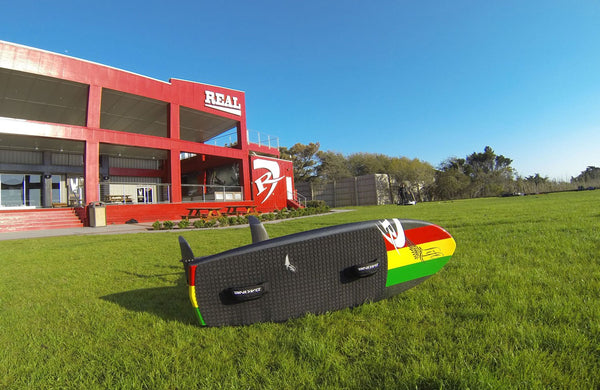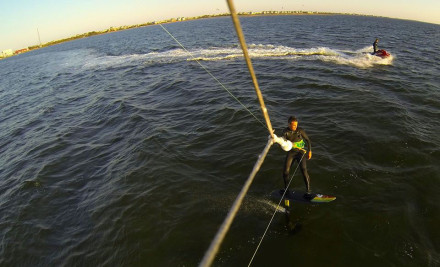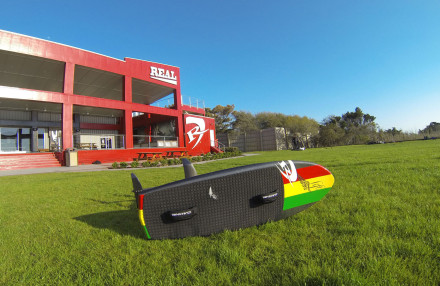Call REAL at 252.987.6000 or email REALpro@realwatersports.com to book your Foilboarding Lessons.
There isn’t a lot of information out there about foilboarding especially for beginners. I thought that it was important to share my experiences as a beginner foilboarder with others and help people make up their mind about getting into foil boarding.
Why do you want to foil board?
Without a doubt the main reason to foilboard is the adrenaline rush of flying over the surface of the water. It is unlike anything that I have done and feels like you are flying a plane. The only difference is that your plane is floating over the surface of the water. There is no noise, no chop, and just no resistance that you are used to while you kiteboard. This is not just “mowing the lawn” back and forth, and the novelty of learning something new does not wear off even after you get it. There is a reason that everyone that foilboards cannot shut up about it when you ask them about it. Foilboarding is truly addictive and will drastically increase the number of days you get on the water.
Other Advantages:
Other advantages are the light wind performance and the upwind/downwind performance of these boards. Your angle of attack upwind is at least double that of a normal kiteboard and you can really maintain speed off the wind. Oh yeah and don’t forget the SPEED! With the limited resistance, you can reach speeds around 30mph with out much effort. Finally you can ride a significantly smaller kite than what you should ride. In my experience you are powered up on a kite that is one to two sizes smaller than what you would normally ride. I have been riding a 12m kite in about 10mph of wind, and I have been fully powered up.
Where can you foil board?
Similar to when kiteboarding started, we heard a lot of, “You can’t do that here.” The reality is that you can foilboard anywhere that there is 5’ of water depth and 10mph of breeze. That is a lot of places. Open oceans, bays, lakes, and sounds all work. We have been kiteboarding in Pamlico Sound, which is known for shallow water depths. Now we are just hunting out the deep spots rather than the shallow Slicks.
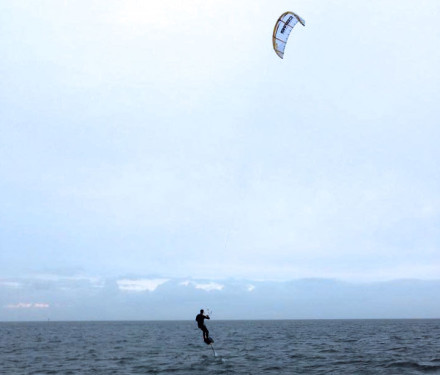
I have seen some really good guys start in water that is shallower than 5’ and hop the board right up on the foil, but for beginners you want to have a consistent depth of 5’ or more. The strut on most boards is 3-4’ so you want a little extra depth so when you come off a foil you will keep the wings from hitting the bottom.
Apart from depth, the only other thing you want to look out for is seaweed. Weed can get caught in the foil and will slow you down quite a bit. It is easy to stop and take the weed off, but if there is a lot of seaweed, you will want to find a different spot.
What board should I get?
Foilboards have been drastically changing over the past five years. We checked out the Carrafino in 2008 and they were one of the early adopters in kiteboarding. Since then two other main brands have taken up most of the market share. The Sword and Lift are now respected as the top quality products on the market. In the research that we did, we found that the Carrafino had a slightly lower price point than the Lift, but the quality and craftsmanship suffered. The Sword is know as the top high speed race foil, but it is very hard to ride and the foil and strut are all one piece so it is hard to travel with. After checking out the MHL factory and looking at the 2014 Lift Foilboard, it was clear that this is the board of choice for everyone but the top racers.
There are a couple features that make the 2014 Lift a great choice. This board was just released in March of 2014 so it is the latest and greatest tech. The Lift can be completely disassemble and fit into a golf bag. The strut(the long part that comes out of the water), fuselage(the part that foils attach to), foil wings(the blades that are in the water to give you lift) and the board all come apart easily. This is not only great for packing but also if you break any parts or new tech comes out, you can just replace the pieces rather than the entire set up.
The main thing that you would change with the Lift are the foils. It comes stock with a recreational foils, which Nick from Lift has clocked himself at 29knots. You can easily switch to the race foils which will get you an extra 5+knots and will be a lot harder to ride. Also if you break the foils from hitting reef, you can replace them for 10% of the cost of a new complete set up. I can tell you that these Lifts are super strong. While learning I have been slamming mine into the bottom of the Pamlico Sound, and I haven’t had so much as a scratch on the foils.
Price:
All of the boards currently available are expensive, but when have the rush of foiling, it is all worth it. At some point there might be a lower price point option, but with amount of carbon that is jammed into these rigs, I don’t see the price dropping any time soon.
A lot of people are cutting some of the expense by bolting their foil to any plank they can get their hands on. I have seen foils on wake skates, race boards, wake boards, and I even saw a guy bolt one to a chair. That being said, I strongly recommend the Lift board. This board has been custom designed over years of R&D to have the right balance point. It also has a large beveled rail across the entire front of the board. When you come down off the foil(which you do a lot as a beginner), this beveled rail keeps the board from pearling and stopping. It forces the board back up off the water and on to the foil.
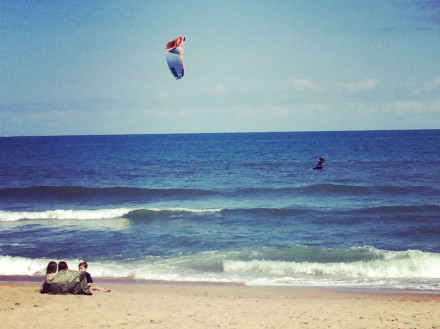
What kites should I ride?
Any kites will work. You will crash your kites a bit at the beginning so you should make sure that they relaunch well. I recommend riding a lot smaller size than what you normally would. A 12m will be the biggest kite you will need and you will definitely want kites down to 7m and 5m for the windier days. I have been riding a 12m in sub 12mph, a 9m in 12-18mph, a 7m in 17-25mph and a 5m in 20mph+. When you start you will want to be sizing just under what you would normally ride. Once you begin foiling for most of your session you will go 2 kite sizes smaller than what you would normally ride.
Do I ride strapped or strapless?
You can ride whatever style you want. Three straps, two straps or none. I strongly recommend using two straps to begin. The first reason is that you need them to hold on to as a handle and body drag with the board properly. Secondly you need the strap as a handle to turn the board on its side and get your feet on it. Once you can foil and handle the board, it is a pretty easy transition to strapless.
Is it hard to learn to Foilboard?
Foiling in the Pamlico Sound
This is the million-dollar question that everyone wants to know. If you are at the Joyride level, can ride most kite sizes in a variety of conditions and can stay upwind, you are ready to try foilboarding. Learning to foilboard is very similar to learning to water start. It is hard to get the board on your feet at first, but then you get it. It is hard to get up on the board, but then you get it. It is hard to ride the foil, but then you get it. In my experience, most people will be foiling in 5-10 sessions. I have seen some get it on their first session and others take much longer. For beginners I do recommend using an impact vest and a helmet. When you wipe out you hit the water from a couple feet up, so you slam a little harder than normal.
Respect:
The foil has a lot of power so you need to respect it like you respected the kite when you started kiteboarding. That being said the learning curve is a blast and once you are up on the foil, you will never question the investment you made in your foilboard. Especially when you are ripping around at really high speeds on a 7m while your friends can barely get going on a 12m.
Call REAL at 252.987.6000 or email REALpro@realwatersports.com to book your Foilboarding Lessons.

